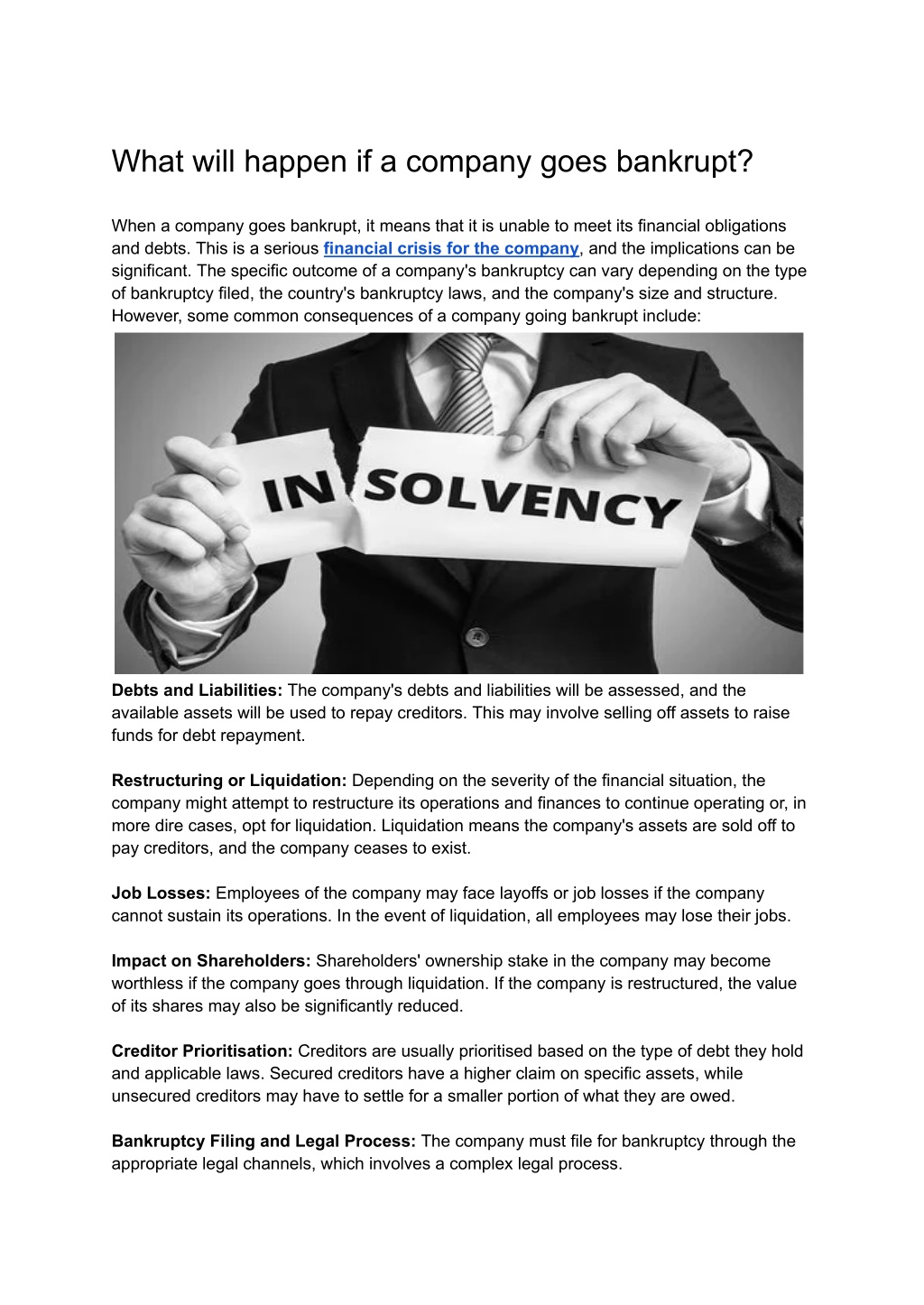Company Administration Explained: What Occurs When Organizations Go into Liquidation?
Company Administration Explained: What Occurs When Organizations Go into Liquidation?
Blog Article
The Process and Effects of a Business Getting Into Administration
As a company faces monetary distress, the decision to go into administration marks an important point that can have far-ranging implications for all involved parties. The procedure of entering administration is detailed, entailing a collection of steps that intend to navigate the business in the direction of prospective recuperation or, sometimes, liquidation. Recognizing the functions and obligations of an administrator, the effect on numerous stakeholders, and the lawful obligations that come into play is vital in understanding the gravity of this situation. The consequences of such a relocation ripple beyond the company itself, forming its future trajectory and influencing the broader service landscape.

Review of Company Administration Process
In the world of business restructuring, an important initial step is getting an extensive understanding of the elaborate business administration procedure. Firm management refers to the formal bankruptcy treatment that intends to save a financially distressed firm or attain a far better outcome for the business's lenders than would certainly be feasible in a liquidation situation. This process includes the visit of an administrator, that takes control of the firm from its supervisors to examine the monetary situation and figure out the best program of action.
During administration, the firm is granted defense from lawsuit by its creditors, offering a moratorium period to develop a restructuring plan. The administrator functions with the firm's management, creditors, and other stakeholders to design a strategy that might include marketing the company as a going issue, getting to a business voluntary plan (CVA) with financial institutions, or eventually placing the firm into liquidation if rescue attempts confirm futile. The main goal of company management is to optimize the return to lenders while either returning the firm to solvency or closing it down in an orderly way.
Functions and Obligations of Administrator
Playing a critical function in overseeing the business's decision-making procedures and economic events, the administrator assumes significant obligations throughout the business restructuring process. The main obligation of the administrator is to act in the most effective interests of the firm's lenders, aiming to achieve the most beneficial outcome feasible. into administration. This involves performing an extensive assessment of the business's monetary scenario, creating a restructuring plan, and implementing strategies to make best use of returns to financial institutions
Furthermore, the manager is responsible for liaising with numerous stakeholders, consisting of workers, distributors, and governing bodies, to guarantee transparency and compliance throughout the administration procedure. They have to likewise communicate efficiently with investors, giving routine updates on the business's development and seeking their input when necessary.
Additionally, the manager plays a critical function in managing the everyday operations of the service, making key decisions to keep continuity and maintain value. This consists of examining the stability of different restructuring choices, negotiating with lenders, and inevitably assisting the business in the direction of an effective departure from administration.
Influence On Company Stakeholders
Thinking a vital setting in managing the business's economic affairs and decision-making processes, the manager's activities during the corporate restructuring procedure have a straight effect on various business stakeholders. Investors may experience a decline in the value of their financial investments as the company's economic troubles are attended to. Lenders, consisting of providers and lending institutions, might encounter uncertainties concerning the payment of debts owed to them. Staff members often run into job instabilities as a result of possible layoffs or modifications in work conditions as part of the restructuring efforts. Consumers may experience interruptions in services or product schedule throughout the management procedure, affecting their trust and commitment towards the firm. Additionally, the community where the company operates might be impacted by prospective job losses or adjustments in the company's procedures, influencing regional economic situations. Efficient communication from the administrator to stakeholders is critical in handling expectations, mitigating issues, and promoting openness throughout the administration procedure.
Legal Implications and Obligations
During the process of company management, careful factor to consider link of the lawful implications and obligations is critical to make sure conformity and shield the passions of all stakeholders entailed. When a company enters administration, it activates a set of legal requirements that must be stuck to.
Furthermore, lawful effects emerge worrying the therapy of staff members. The administrator has to comply with work regulations concerning redundancies, worker legal rights, and obligations to provide essential details to employee representatives. what happens to employees when a company goes into liquidation. Failure to abide by these legal needs can cause lawful activity against the firm or its managers
In addition, the business entering management might have legal responsibilities with different parties, consisting of landlords, suppliers, and consumers. In significance, understanding and meeting lawful obligations are essential elements of navigating a firm through the management process.
Methods for Company Healing or Liquidation
In considering the future direction of a firm in management, critical planning for either healing or liquidation is vital to chart a feasible path forward. When aiming for firm recovery, essential approaches may consist of carrying out a detailed analysis of the service operations to determine inefficiencies, renegotiating contracts or leases to enhance cash circulation, and implementing cost-cutting actions to boost profitability. Additionally, looking for new financial investment or funding options, expanding revenue streams, and concentrating on core competencies can all contribute to a successful recuperation plan.
Alternatively, in scenarios where business liquidation is deemed one of the most appropriate strategy, methods would certainly involve making best use of the worth of possessions through efficient property sales, working out outstanding debts in a structured fashion, and abiding by lawful demands to ensure a Read Full Report smooth winding-up process. Communication with stakeholders, consisting of financial institutions, employees, and consumers, is crucial in either circumstance to keep transparency and take care of expectations throughout the healing or liquidation procedure. Inevitably, selecting the best approach depends upon an extensive analysis of the company's financial health, market position, and lasting prospects.
Verdict
To conclude, the procedure of a company getting in administration involves the visit of a manager, who takes on the duties of handling the company's events. This process can have significant repercussions for numerous stakeholders, consisting of investors, employees, and lenders. It is very important for business to thoroughly consider their options and strategies for either recouping from economic problems or waging liquidation in look at here order to minimize possible legal implications and obligations.
Company management refers to the official bankruptcy procedure that intends to save a monetarily distressed company or achieve a far better result for the firm's lenders than would be feasible in a liquidation circumstance. The manager functions with the firm's administration, lenders, and various other stakeholders to develop an approach that may entail marketing the organization as a going issue, getting to a business volunteer arrangement (CVA) with lenders, or ultimately putting the company into liquidation if rescue attempts verify useless. The key goal of firm administration is to optimize the return to financial institutions while either returning the firm to solvency or shutting it down in an organized fashion.

Report this page